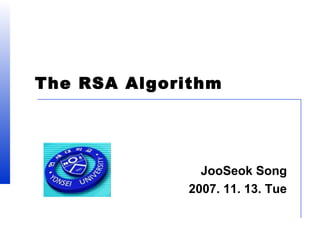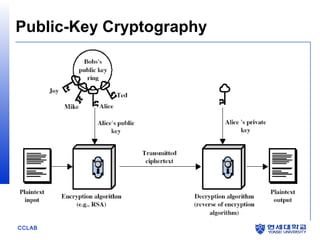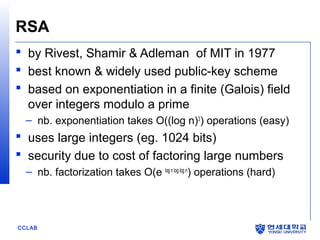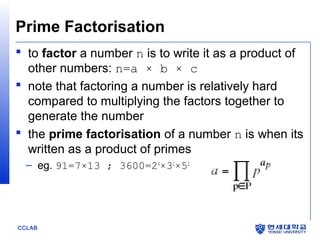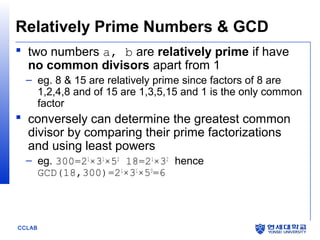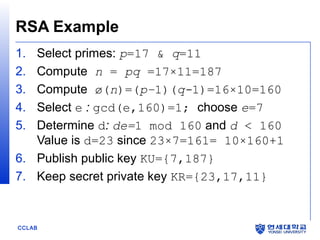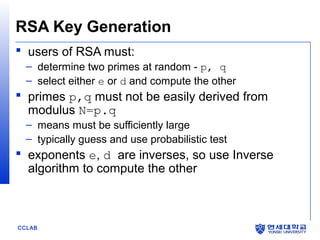The rsa algorithm
- 1. The RSA Algorithm JooSeok Song 2007. 11. 13. Tue
- 2. CCLAB Private-Key Cryptography traditional private/secret/single key cryptography uses one key shared by both sender and receiver if this key is disclosed communications are compromised also is symmetric, parties are equal hence does not protect sender from receiver forging a message & claiming is sent by sender
- 3. CCLAB Public-Key Cryptography probably most significant advance in the 3000 year history of cryptography uses two keys – a public & a private key asymmetric since parties are not equal uses clever application of number theoretic concepts to function complements rather than replaces private key crypto
- 4. CCLAB Public-Key Cryptography public-key/two-key/asymmetric cryptography involves the use of two keys: – a public-key, which may be known by anybody, and can be used to encrypt messages, and verify signatures – a private-key, known only to the recipient, used to decrypt messages, and sign (create) signatures is asymmetric because – those who encrypt messages or verify signatures cannot decrypt messages or create signatures
- 6. CCLAB Why Public-Key Cryptography? developed to address two key issues: – key distribution – how to have secure communications in general without having to trust a KDC with your key – digital signatures – how to verify a message comes intact from the claimed sender public invention due to Whitfield Diffie & Martin Hellman at Stanford Uni in 1976 – known earlier in classified community
- 7. CCLAB Public-Key Characteristics Public-Key algorithms rely on two keys with the characteristics that it is: – computationally infeasible to find decryption key knowing only algorithm & encryption key – computationally easy to en/decrypt messages when the relevant (en/decrypt) key is known – either of the two related keys can be used for encryption, with the other used for decryption (in some schemes)
- 9. CCLAB Public-Key Applications can classify uses into 3 categories: – encryption/decryption (provide secrecy) – digital signatures (provide authentication) – key exchange (of session keys) some algorithms are suitable for all uses, others are specific to one
- 10. CCLAB Security of Public Key Schemes like private key schemes brute force exhaustive search attack is always theoretically possible but keys used are too large (>512bits) security relies on a large enough difference in difficulty between easy (en/decrypt) and hard (cryptanalyse) problems more generally the hard problem is known, its just made too hard to do in practise requires the use of very large numbers hence is slow compared to private key schemes
- 11. CCLAB RSA by Rivest, Shamir & Adleman of MIT in 1977 best known & widely used public-key scheme based on exponentiation in a finite (Galois) field over integers modulo a prime – nb. exponentiation takes O((log n)3 ) operations (easy) uses large integers (eg. 1024 bits) security due to cost of factoring large numbers – nb. factorization takes O(e log n log log n ) operations (hard)
- 12. CCLAB RSA Key Setup each user generates a public/private key pair by: selecting two large primes at random - p, q computing their system modulus N=p.q – note ø(N)=(p-1)(q-1) selecting at random the encryption key e where 1<e<ø(N), gcd(e,ø(N))=1 solve following equation to find decryption key d – e.d=1 mod ø(N) and 0≤d≤N publish their public encryption key: KU={e,N} keep secret private decryption key: KR={d,p,q}
- 13. CCLAB RSA Use to encrypt a message M the sender: – obtains public key of recipient KU={e,N} – computes: C=Me mod N, where 0≤M<N to decrypt the ciphertext C the owner: – uses their private key KR={d,p,q} – computes: M=Cd mod N note that the message M must be smaller than the modulus N (block if needed)
- 14. CCLAB Prime Numbers prime numbers only have divisors of 1 and self – they cannot be written as a product of other numbers – note: 1 is prime, but is generally not of interest eg. 2,3,5,7 are prime, 4,6,8,9,10 are not prime numbers are central to number theory list of prime number less than 200 is: 2 3 5 7 11 13 17 19 23 29 31 37 41 43 47 53 59 61 67 71 73 79 83 89 97 101 103 107 109 113 127 131 137 139 149 151 157 163 167 173 179 181 191 193 197 199
- 15. CCLAB Prime Factorisation to factor a number n is to write it as a product of other numbers: n=a × b × c note that factoring a number is relatively hard compared to multiplying the factors together to generate the number the prime factorisation of a number n is when its written as a product of primes – eg. 91=7×13 ; 3600=24 ×32 ×52
- 16. CCLAB Relatively Prime Numbers & GCD two numbers a, b are relatively prime if have no common divisors apart from 1 – eg. 8 & 15 are relatively prime since factors of 8 are 1,2,4,8 and of 15 are 1,3,5,15 and 1 is the only common factor conversely can determine the greatest common divisor by comparing their prime factorizations and using least powers – eg. 300=21 ×31 ×52 18=21 ×32 hence GCD(18,300)=21 ×31 ×50 =6
- 17. CCLAB Fermat's Theorem ap-1 mod p = 1 – where p is prime and gcd(a,p)=1 also known as Fermat’s Little Theorem useful in public key and primality testing
- 18. CCLAB Euler Totient Function ø(n) when doing arithmetic modulo n complete set of residues is: 0..n-1 reduced set of residues is those numbers (residues) which are relatively prime to n – eg for n=10, – complete set of residues is {0,1,2,3,4,5,6,7,8,9} – reduced set of residues is {1,3,7,9} number of elements in reduced set of residues is called the Euler Totient Function ø(n)
- 19. CCLAB Euler Totient Function ø(n) to compute ø(n) need to count number of elements to be excluded in general need prime factorization, but – for p (p prime) ø(p) = p-1 – for p.q (p,q prime) ø(p.q) = (p-1)(q-1) eg. – ø(37) = 36 – ø(21) = (3–1)×(7–1) = 2×6 = 12
- 20. CCLAB Euler's Theorem a generalisation of Fermat's Theorem aø(n) mod N = 1 – where gcd(a,N)=1 eg. – a=3;n=10; ø(10)=4; – hence 34 = 81 = 1 mod 10 – a=2;n=11; ø(11)=10; – hence 210 = 1024 = 1 mod 11
- 21. CCLAB Why RSA Works because of Euler's Theorem: aø(n) mod N = 1 – where gcd(a,N)=1 in RSA have: – N=p.q – ø(N)=(p-1)(q-1) – carefully chosen e & d to be inverses mod ø(N) – hence e.d=1+k.ø(N) for some k hence : Cd = (Me )d = M1+k.ø(N) = M1 .(Mø(N) )q = M1 .(1)q = M1 = M mod N
- 22. CCLAB RSA Example 1. Select primes: p=17 & q=11 2. Compute n = pq =17×11=187 3. Compute ø(n)=(p–1)(q-1)=16×10=160 4. Select e : gcd(e,160)=1; choose e=7 5. Determine d: de=1 mod 160 and d < 160 Value is d=23 since 23×7=161= 10×160+1 6. Publish public key KU={7,187} 7. Keep secret private key KR={23,17,11}
- 23. CCLAB RSA Example cont sample RSA encryption/decryption is: given message M = 88 (nb. 88<187) encryption: C = 887 mod 187 = 11 decryption: M = 1123 mod 187 = 88
- 24. CCLAB Exponentiation can use the Square and Multiply Algorithm a fast, efficient algorithm for exponentiation concept is based on repeatedly squaring base and multiplying in the ones that are needed to compute the result look at binary representation of exponent only takes O(log2 n) multiples for number n – eg. 75 = 74 .71 = 3.7 = 10 mod 11 – eg. 3129 = 3128 .31 = 5.3 = 4 mod 11
- 26. CCLAB RSA Key Generation users of RSA must: – determine two primes at random - p, q – select either e or d and compute the other primes p,q must not be easily derived from modulus N=p.q – means must be sufficiently large – typically guess and use probabilistic test exponents e, d are inverses, so use Inverse algorithm to compute the other
- 27. CCLAB RSA Security three approaches to attacking RSA: – brute force key search (infeasible given size of numbers) – mathematical attacks (based on difficulty of computing ø(N), by factoring modulus N) – timing attacks (on running of decryption)
- 28. CCLAB Factoring Problem mathematical approach takes 3 forms: – factor N=p.q, hence find ø(N) and then d – determine ø(N) directly and find d – find d directly currently believe all equivalent to factoring – have seen slow improvements over the years as of Aug-99 best is 130 decimal digits (512) bit with GNFS – biggest improvement comes from improved algorithm cf “Quadratic Sieve” to “Generalized Number Field Sieve” – barring dramatic breakthrough 1024+ bit RSA secure ensure p, q of similar size and matching other constraints
- 29. CCLAB Timing Attacks developed in mid-1990’s exploit timing variations in operations – eg. multiplying by small vs large number – or IF's varying which instructions executed infer operand size based on time taken RSA exploits time taken in exponentiation countermeasures – use constant exponentiation time – add random delays – blind values used in calculations
- 30. CCLAB Summary have considered: – prime numbers – Fermat’s and Euler’s Theorems – Primality Testing – Chinese Remainder Theorem – Discrete Logarithms – principles of public-key cryptography – RSA algorithm, implementation, security
- 31. CCLAB Assignments 1. Perform encryption and decryption using RSA algorithm, as in Figure 1, for the following: a. p = 3; q = 11, e = 7; M = 5 b. p = 5; q = 11, e = 3; M = 9 2. In a public-key system using RSA, you intercept the ciphertext C = 10 sent to a user whose public key is e = 5, n = 35. What is the plaintext M? 31 Encryption Decryption Plaintext 88 Ciphertext 11 Plaintext 88 887 mod 187 = 11 1123 mod 187 = 88 KU = 7, 187 KR = 23, 187 Figure 1. Example of RSA Algorithm
